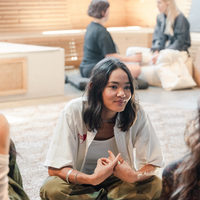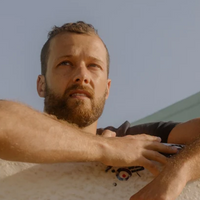Bands know they’ve hit it big when they’re performing to fan-packed arenas. For a sound artist specializing in meditation, touring venues typically reserved for Beyoncé and NBA games is an unheard of level of impact—especially when, as The Big Quiet’s sound director Jackie Cantwell explains, the gig is basically the opening act for Oprah Winfrey.
The Big Quiet visited nine cities with Oprah’s sold-out 2020 Vision: Your Life in Focus tour early last year. Cantwell played crystal quartz singing bowls to crowds of 15,000 while The Big Quiet’s founder, Jesse Isreal, guided meditations. “I’ve never felt that connected to anything I’ve ever done,” says Cantwell. “The sense of shared experience was profound.”
Sharing the stage with Oprah was also next level, Cantwell says from her home in Venice, California. “To see her with her eyes closed, listening to the sound of the bowls, was surreal,” she says.
The wellness mogul is among a growing number of big names promoting sound meditation, or sound baths, as they’re also commonly called. (Sound baths are named for the process of sound waves from the singing bowls “washing” over the body.) What was once niche territory for shamanic healing ceremonies and New Age bookstores has amassed such a following that, pre-pandemic, you could find sound baths advertised in art galleries, museums, yoga studios, and such major landmarks as New York’s Madison Square Garden, San Francisco’s Grace Cathedral, and London’s Hyde Park. Fortune 500 companies Coca-Cola, Adidas, and Ford hire sound healers to lead corporate meditation sessions, while Audible and Calm offer subscribers sound baths from the comfort of their own earbuds.
Science is still catching up to the benefits of sound and music healing practices that stretch back tens of thousands of years. But separate studies in 2013 and 2016 on the effects of sound meditation using metal singing bowls showed the intervention reduces tension in the mind and body. In person, sound vibrations are so intense it can feel like they’re emanating inside the body or physically releasing tension in the chest cavity. When you switch to computer speakers and earbuds, the experience is less visceral, but still impactful—getting a targeted sonic release via headphones has been shown to relieve anxiety.
The ancient practice was not well known in the United States until recently. Brooklyn sound therapy practitioner Nate Martinez says when he first started hosting sound baths in 2014, New Yorkers had no idea what he was talking about. One woman asked how he was able to “cart bathtubs around New York City” while others called the Brooklyn Zen Center before his events there to ask if they should bring towels and bathing suits. Now Google’s senior global leadership are among the executives hiring Martinez to lead sound meditations on corporate retreats.
At its core, Martinez says that a sound bath is a deep listening experience that allows the body to fully rest. “You redirect energy you might otherwise use on different senses and explore your subconscious,” says Martinez, a musician who studied sound therapy at New York’s holistic institution Open Center. “It calms the nervous system and can untether the mind. Intuitive information gets amplified. It’s a great opportunity to not have to do much but to potentially gain a lot of perspective.”
Sound meditation involves a variety of musical tools, from the popular crystal quartz singing bowls and Himilayan (commonly called Tibetan) singing bowls to drone and percussive instruments, and they hail from cultures and traditions around the world.
Jazz vocalist and life-enrichment facilitator Fred Johnson spent nine years training with West African healing masters. He incorporates African instruments such as the chordophone, kora, and traditional drums into his practice. “The drum has one of the first rhythms and connections that we align ourselves with in utero: the sound of our mother’s heartbeat,” he says.
Johnson, who has run sound meditations around the world from his base in St. Petersburg, Florida, has seen interest in this work rise in recent years.
“People are seeking experiences that bring them calm from the inside out because so much of what we’ve experienced, especially in the past few years, has been hurtful, unnerving, and disarming,” he says. “They’re looking for assurances that things will be OK, and to find that within themselves.”
Using sound to deepen a sense of rest is a political act for Black communities, says Heather Archer, a Walnut Creek, California-based sound healer. The co-founder of Black Healers Connect says she’s been using sound meditation in her work for years, but the intersection of shelter-in-place mandates with the amplification of white supremacy’s impact on communities of color made the need more pressing in the past year.
“When you look at the stats, you see that Black and Latinx Americans have the worst sleep patterns,” Archer says. These patterns are often triggered by shift and graveyard work disproportionately taken on by these communities, mixed with a fear of racialized violence, she says.
“As a Black woman, when I say I’m worthy of rest, I speak not just for myself but for my ancestors, who literally could not say that in their time,” says Archer. “Pause and rest is a political act in a society that’s go-go-go.”
She says sound meditation is a safe space for that rest to take place. “Especially for people who have a hard time being still,” she adds, “where meditation is difficult. That’s how I started my own sound meditation journey. I needed help meditating and resting. Sound was a really great scaffold for me.”
The collective anxiety over the past year has intensified our need for healing practices while also making them more accessible to those with the time and technology to connect. Sound meditations, like many public rituals, have moved from idealized spaces—such as soundproofed studios and the acoustically perfect Integratron near Joshua Tree, California—into the virtual world. This shift dropped the price tag for many of these experiences from upward of $25 for an IRL session to a more manageable cost ranging from free (on platforms like YouTube, Facebook, and Instagram Live, where Archer and The Big Quiet’s Cantwell host short sessions) to under $10. This change is helping people incorporate sound baths into their routines more regularly.
Virtual sound meditation seems here to stay.
“It’s been such a wild journey of letting go of perfectionism, of trusting that whatever sound comes through is the sound that needs to be heard,” says Cantwell. “We were worried in the beginning that the sound wouldn’t transfer in the most powerful way, but it does, and there’s something special that happens online. The sound these instruments create is pretty otherworldly, and when it comes through Zoom and Instagram some strange things happen.”
Johnson agrees. “Zoom isn’t just your eyes and ears, it can be your whole being,” he says. The bigger issue faced today, he adds, is purpose rather than platform.
“We’re being called to rediscover the pure essence of our humanity,” Johnson says, “and to me that’s what meditation is all about. Whether it’s silent or with sound, the question is, ‘Who am I from the inside out?’”




